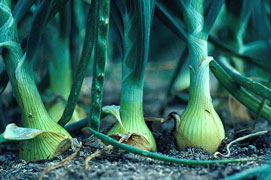


Home
Flowers &
Indoor Plants
Fruits & Nuts
Ornamentals
Vegetables
Special Topics
Resources
Glossary

|
Onion Allium cepa (al-ee-um see-pah)  


Click on thumbnails for larger image. |
 |
What about it? Onions are in the Amaryllis family with garlic, leeks, and shallots. Onions and shallots have rounded, cylindrical shaped leaves while garlic and leeks have flattened leaves. The scales of the onion bulb are actually modified leaves that provide protection from water loss. Onions come in red, purple, brown, white, and yellow varieties. There are some well known sweet varieties such as 'Vidalia' and 'Walla Walla'. What is it used for? The bulb is the edible part of the onion plant. However, you can harvest the plant earlier in the season to use as scallions. Scallions are the "green onions" or leaves of the onion plant called for in some recipes. Where does it grow? How do we grow it? Onions like fertile, well-drained soil. Weeding is the big thing when it comes to growing onions. Their small tufts of leaves have difficulty compering with other garden strays. Keep their area clear so that they can get plenty of sunshine. What are its primary problems? Onions typically are not bothered by many pests. Sometimes an encounter with an onion maggot or thrips may be troublesome. How do we propagate it? Start onion plants indoors 2-3 months before the last frost date. If you are feeling adventuresome you can sow the seeds d i rectly into the soil as soon as the soil can be worked. Set transplants into the ground at 4 inch intervals. If you want bigger onions leave 6 inches in between plants. Direct seeded onions should be thinned. If you are growing bulb onions, space them 4 inches apart; scallions need 1-2 inches. How do we harvest and store it? Onion leaves will signal when the plants are ready for harvest. When the leaves fall over, give the plant 10 more days and then harvest. Dig onions out of the ground rather than trying to pull them out. Onions need to be cured after harvesting to reduce the chance of infection. Curing requires storing onions at 75-80 degrees for 2 weeks, or until the outer skin layers have become opaque and dry. After storing, the leaves can be cut, and onions can be refrigerated for several months or more.
© Copyright, Department of Horticulture, Cornell University. |